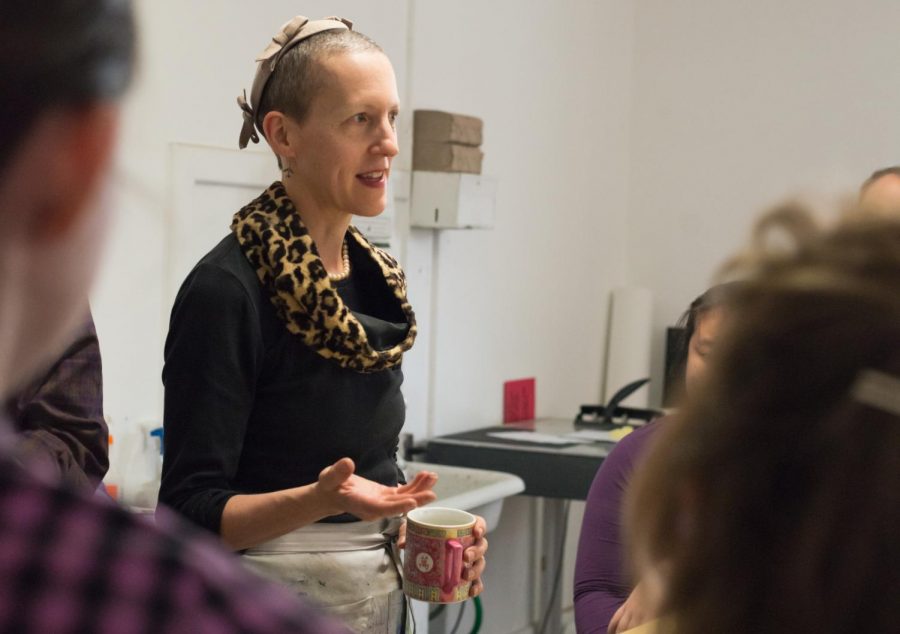Longtime OSU professor and respected artist dies at age 60
Courtesy of OSU Associate Professor Julia Bradshaw
Oregon State University Professor Julie Green teaches a class while drinking their favorite green tea. Green taught painting to advanced students in the BFA program at OSU.
October 28, 2021
For Julie Green, every aspect of life was a chance to make art—from their carefully composed office space, to the clothes they wore and the details of food they made for friends.
Green, who was an Oregon State University professor for twenty years, was a passionate proponent of routine and detail, their work ethic underpinning everything they did in life.
According to Anna Fidler, a fellow painter, OSU art instructor and one of their best friends, Green began every day with a practice of painting their garden onto a paper plate. They could often be found in the morning jumping on the trampoline at Fidler’s house, which was just five doors down from theirs. Green lived in Corvallis, Ore. with their husband, Clay Lohmann, and cat, Mini.
The paper plates Green painted in their mornings are synonymous with their most widely-recognized project called “The Last Supper.” Green began painting the last meals of prison inmates on death row in cobalt blue onto ceramic plates as a call to action for prison reform.
The work was planned to be an ongoing project that would not be complete until the United States abolished the death penalty, but which Green finished at 1000 plates due to the severity of their health condition.
“The Last Supper” was on display in the Bellevue Arts Museum in Washington when Green died on Oct. 12 of ovarian cancer.
“They had this private approach to life,” said Fidler. “Having a circle of very close friends, which I felt a privilege to be a part of. And from that, every basic, waking minute could be applied to thinking about artwork, and in some ways, about changing the world in a positive way, like her “Last Supper” piece. It’s almost like clocking in, like you wake up, your eyes are open, you’re clocked in, it’s another day and you’re going to be the most creative human being you’re capable of being. Then you close your eyes and clock out.”
This creative and careful mindset was present at all times for Julie: at their home, in their studio and with their students and colleagues.
Shelley Jordon is a painter and professor of fine arts at OSU who, over the course of the last twenty years, worked with Green to further develop the B.F.A. studio art program for painting at OSU.
Jordon said her respect for Green as an artist and a teacher was immense and that their working relationship deepened over the course of the past two years after Green was diagnosed with cancer.
“They were very stylish. Always,” Jordon said. “The most stylish person I have ever known… and they wore great hats. Which they made. Julie was extremely disciplined and had great clarity of vision… they were committed to their art, to their students, to social causes and to their career.”
By example, Jordon said, Green showed students how to be a working professional artist, a wonderful educator and set an example in Jordon’s own life, as someone with the will to do exactly what they wanted to do.
Green’s compassion, extremely driven nature, meticulous care for detail and commitment to art and social justice were the traits that guided their everyday life. Their impact on the people they loved, worked with and taught was never overstated.
Johnny Beaver, a former student of Green’s who now teaches painting classes at OSU, said Green created a sense of community and a standard for which their students could strive for, and their influence was present within the students in Beaver’s entire undergraduate cohort.
“They were both an extremely powerful and very vulnerable person at the same time, and those two aspects of them worked together very well,” Beaver said.
According to Beaver, Green was like a mentor to him and an inspiration to him and so many of the other students Green taught at OSU. His value system as an artist and a professional, Beaver said, was shaped by the influence that Green’s life had on him and the rest of the people who were lucky enough to know them.
“They knew how to do something that I don’t know if I’ll ever figure out how to do as an educator,” Beaver said. “They knew where to push, and where to be tough, and where to not be tough, and how to do it all. A lot of the things that I carry with me in my own art practice are things that Julie told me not to do. They knew I was a contrarian, and they knew how to use that to get me to a position of making my own choices, and that’s the goal of where you want your students to be when they exit undergrad with a BFA, owning their work; being the world’s foremost expert on themselves… I’ve never seen somebody so in touch with how they wanted to live.”
























































































































